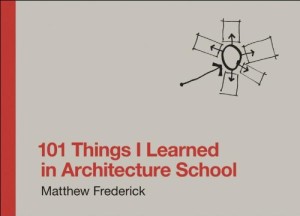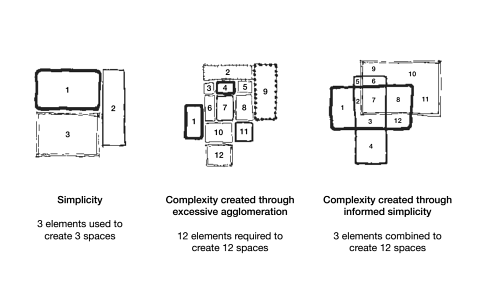 The first book in our UX Bookclub series is a personal favorite, and one which is dear to my heart. Matthew Frederick’s 101 Things I Learned in Architecture School, should be a classic in any user experience curriculum.
The first book in our UX Bookclub series is a personal favorite, and one which is dear to my heart. Matthew Frederick’s 101 Things I Learned in Architecture School, should be a classic in any user experience curriculum.
Firstly, my interest in user experience and design as formulated in my time studying as an Urban Planner. Often, I find myself [at job interviews in particular], being asked to justify my non-traditional educational background for my career path. This book sums it up fairly nicely in my opinion.
The Big idea
On page 40, Frederick suggests that good designs should have a “Parti pris” or a central idea/concept: UX practitioners, particularly when wearing their interaction and visual design hats can benefit from keeping this in mind. When drawing a wireframe, it is worth stepping back to ask “what does it all mean” or “what is it all leading to.” Architects know that symbolic design, can invoke certain feelings or sentiments, even at a subconscious level. Is there a conflict? You may not be able to point to it at first glance, but it can be felt.
When we design something on the page, can the sum of the parts be greater than meeting a list of requirements? Sure there’s your navigation, your main content, your advertising space, but without a parti, have you really designed something? I find that having an overall idea is helpful for beginning to think of how simplicity can create legibilities out of complexity. The diagrams on page 101 are certainly an architectural base, but what UX designer hasn’t sketched nearly the same thing in trying to understand a product?
And of course, as important as the big idea is: You should never become too attached to it (page 68).

Another remark which rang true was the quote about architects and engineers. Though the current move towards UX specialization in the field might reflect a change away from this, this notion of “An architect knows something about everything. An Engineer knows everything about one thing” (page 52) still feels true. In the world of UX, we must work with front-end developers, back-end developers, business and account folks, in addition to project managers. We are uniquely positioned in that to do our job well, we must know enough to negotiate and understand others’ perspectives [and know enough to know what we don’t know].
“An architect knows something about everything. An Engineer knows everything about one thing”
It’s about the Thinking
Another piece of advice which Frederick puts so succinctly is his reminder “The most effective, most creative problem solvers engage in a process of meta-thinking, or ‘thinking about the thinking.'” (page 74)
This in general is a succinct description of the philosophy I try to embody in my practice. We often end up like architects do, mired in the details about product (page 68). But without taking the time to think about the big picture, and the why we think about the picture, we risk losing our parti, losing our users, and losing what we bring to the craft of creating great products and experiences.
…its that the view from height forces one to “[accept] the anxiety that comes from not knowing what to do”
This view at 40,000 feet that might be uncomfortable for some. Either you’re afraid of heights, or its that the view from height forces one to “[accept] the anxiety that comes from not knowing what to do” (page 68) from seeing the big picture. To realize the chaos and complexity that we’re trying to understand. These things may not always be able to be reigned in, or made simple. But understanding how we’re imposing simplicity, and what lens we are bringing to the process helps us to clarify our perspective. This in turns helps us to better articulate the value hypothesis, and test it with our users.
